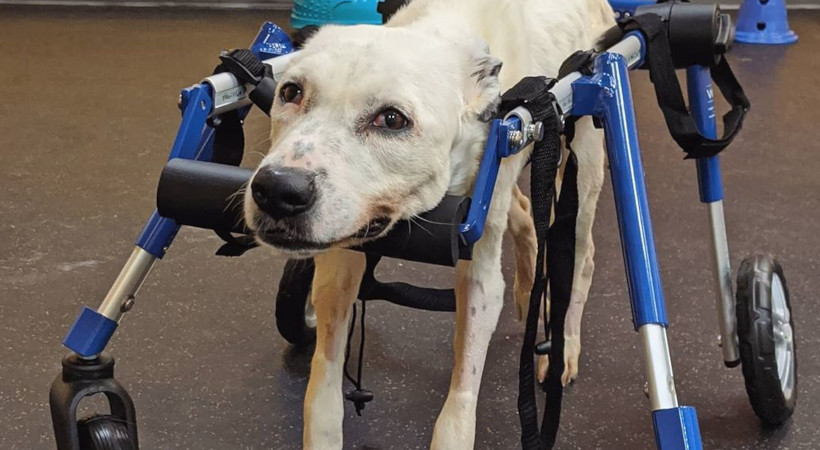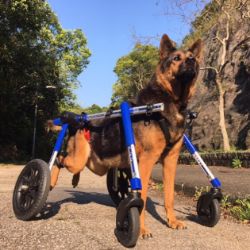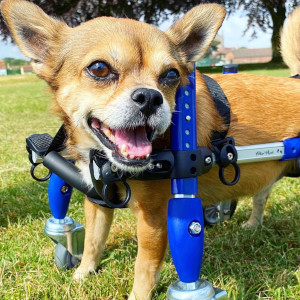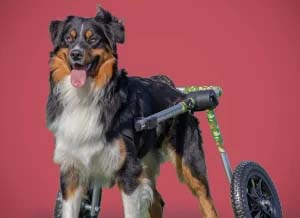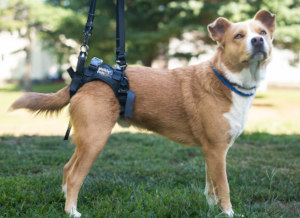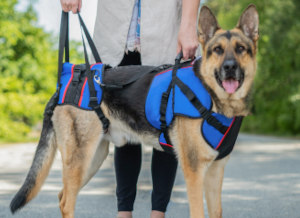Otto, a 10-year-old Labrador Retriever, gave his owners quite the scare one morning when he began stumbling, falling over, and acting drunk.
His owners noticed that he seemed nauseous and that his eyes were darting back and forth. They quickly rushed him to the emergency hospital, where he was diagnosed with Idiopathic Vestibular Disease, a common condition among senior dogs.
Vestibular disease can look scary, especially when the symptoms come on as suddenly as Otto’s did. Fortunately, vestibular disease often resolves on its own with time and supportive care, although some types of vestibular disease require further treatment to see improvement.
What is Vestibular Disease in Dogs?
The vestibular system is a delicate sensory system that provides the brain with information about your body’s motion, head position, and orientation in space.
It is composed of two parts: the peripheral portion, which includes the structures of the inner ear and the vestibulocochlear nerve, and the central portion, which includes the brainstem nuclei and portions of the spinal cord and brain.
When the vestibular system experiences dysfunction, a loss of balance occurs, resulting in symptoms that include impaired coordination, dizziness, rolling, falling, head tilt, and abnormal eye movements called nystagmus. Vestibular disease can occur in any age or breed of dog and may have an acute (sudden) or chronic (gradual) onset.
What Causes Vestibular Disease in Dogs
Vestibular disease in dogs has many potential causes. One of the most common causes of vestibular disease is otitis media or otitis interna, an infection of the middle or inner ear.
Other potential causes of vestibular disease in dogs include:
- Infectious meningitis
- Meningoencephalitis
- Vascular infarcts
- Neoplasia (cancer) of the temporal bone
- Peripheral nerve sheath tumors
- Tumors of the brain stem or cerebellum
- Hypothyroidism
- Systemic hypertension
- Thiamine deficiency
- Congenital malformation
- Toxins
- Trauma
Sometimes, vestibular disease can be idiopathic, which means we don’t know the cause. Old Dog Vestibular Disease, a condition occurring in senior dogs, is an idiopathic condition because we don’t know why these dogs suddenly develop vestibular symptoms.
What Are the Symptoms of Vestibular Disease in Dogs?
The symptoms of vestibular disease are associated with a loss of balance.
Common signs include:
- Rolling
- Falling
- Head tilt to one side
- Nystagmus (abnormal eye movements)
- Weakness
- Loss of coordination
- Nausea
- Vomiting
- Facial paralysis
- Signs of ear infection
How is Vestibular Disease in Dogs Treated?
Treating vestibular disease in dogs starts with treating the underlying cause of the problem, if possible.
For example, this may mean treating the underlying ear infection, addressing endocrine abnormalities such as hypothyroidism, or treating an underlying thiamine deficiency. Your veterinarian will determine your dog’s best course of treatment based on its history, health status, and symptoms.
Supportive Care
In idiopathic cases with no evident cause, the best we can do is offer the dog supportive care while waiting for the condition to improve. Supportive care for dogs with vestibular disease often includes several medications.
These include anti-emetics such as Cerenia to reduce nausea and motion sickness associated with the loss of balance. Meclizine, an over-the-counter antihistamine, may also be administered to help combat the effects of motion sickness. Some dogs may become anxious due to vestibular disease, so anti-anxiety medication such as diazepam may also be prescribed.
Good nursing care is also a staple of vestibular disease treatment. Affected patients often feel dizzy and disoriented, so a calm and quiet environment is best for recovery. Patients may need gentle assistance to move from one position to another and should be rotated every 4-6 hours to prevent the development of bed sores.
Good Hygiene
Good hygiene is also necessary to keep your dog clean, as they may be unable to get up to go to the bathroom outside. You may also need to bring food and water to your pet as it could be difficult for them to reach the bowl on their own.
Assist Your Pet
Balance issues are prevalent in dogs with a vestibular disorder. Your dog may need support to stand and walk. Use a lifting harness to help support your dog and keep them upright. Pets with persistence wobbling and loss of balance may benefit from a 4-wheel wheelchair for additional support and help them maintain their balance as they walk.
A Note from Walkin’ Pets:
If your pet is dealing with symptoms like anxious behavior, nausea, or discomfort, hemp products may be effective at supporting them. Countless pet owners use full-spectrum, third-party-tested hemp products to promote relaxation and ease discomfort in their dogs.
If you choose this route, it’s important that you find a reputable brand. Only transparent brands with third-party testing should be trusted, particularly when it comes to hemp products. We recommend Lolahemp’s chewables & oils.
Lolahemp provides extremely high-quality products and has a wonderful track record of supporting thousands upon thousands of dogs with the discomfort, anxious behavior, and nausea associated with some canine ailments.
How Long Does Vestibular Disease in Dogs Last?
With treatment, most dogs with vestibular disease begin to show improvement within a few days. However, it can take as long as two to three weeks for vestibular disease in dogs to fully improve.
Some signs of vestibular disease in dogs, such as a head tilt or facial paralysis, may never fully resolve even after the vestibular disease has passed. If your dog’s vestibular disease seems to worsen or is not improving after several weeks, contact your veterinarian, as further diagnostics and treatment may be necessary.
Understanding Vestibular Disease in Canines
Vestibular disease can occur in any age or breed of dog, although idiopathic vestibular disease – “Old Dog Vestibular Disease” – is more common in seniors. Symptoms of vestibular disease are associated with loss of balance and can look quite dramatic, especially in acute disease.
Treatment of vestibular disease focuses on addressing the underlying cause of vestibular system dysfunction if one can be identified. If the condition is idiopathic, treatment focuses on supportive care with anti-emetic medications and good nursing care.
Most dogs recover in 2-3 weeks, though some signs, such as a head tilt, can persist after the disease has resolved. If you suspect your dog may have a vestibular disease, contact your veterinarian right away for appropriate diagnosis and treatment.
Guest Author:
Elizabeth Racine, DVM
Dr. Elizabeth Racine is a small animal veterinarian with a passion for improving the lives of pets. She has worked in the veterinary field in various roles for more than a decade, with professional interests in behavior, nutrition, and palliative care. As a writer, her work has been featured by several world-renowned pet health and wellness brands. Dr. Racine shares her home with her dog Dasher – a beagle with his own storied career training new veterinary students – and her trouble-making orange cat named Julius.
